2007 Hyundai H-1 (Grand Starex) brake
[x] Cancel search: brakePage 158 of 284
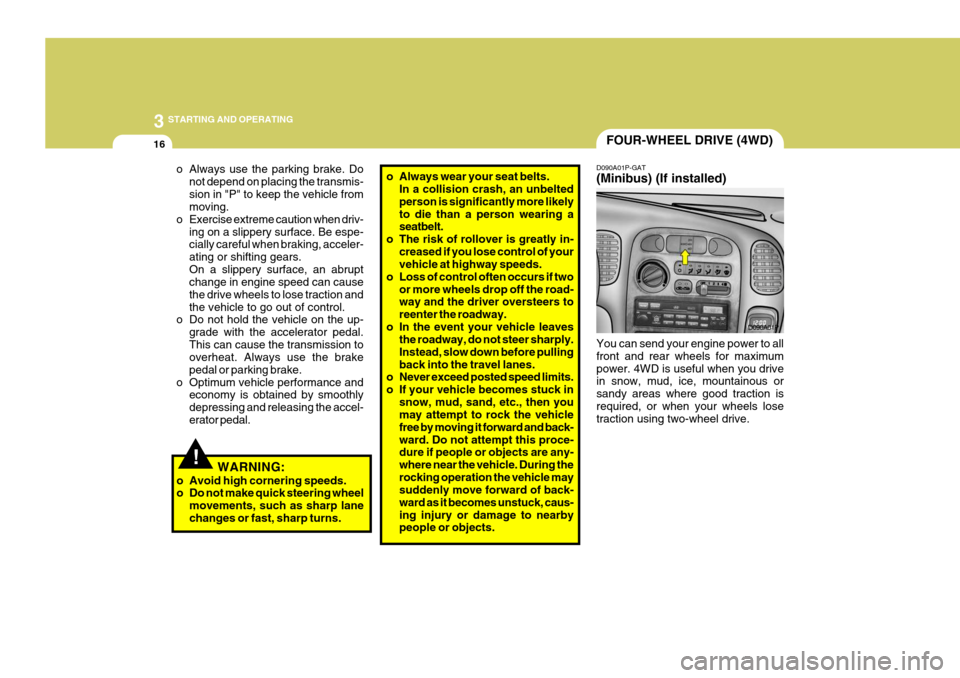
3 STARTING AND OPERATING
16
o Always use the parking brake. Do
not depend on placing the transmis- sion in "P" to keep the vehicle from moving.
o Exercise extreme caution when driv-
ing on a slippery surface. Be espe-cially careful when braking, acceler- ating or shifting gears.On a slippery surface, an abrupt change in engine speed can cause the drive wheels to lose traction andthe vehicle to go out of control.
o Do not hold the vehicle on the up-
grade with the accelerator pedal.This can cause the transmission to overheat. Always use the brake pedal or parking brake.
o Optimum vehicle performance and economy is obtained by smoothlydepressing and releasing the accel-erator pedal.
WARNING:
o Avoid high cornering speeds.
o Do not make quick steering wheel movements, such as sharp lane changes or fast, sharp turns.
FOUR-WHEEL DRIVE (4WD)
D090A01P-GAT (Minibus) (If installed) You can send your engine power to all front and rear wheels for maximumpower. 4WD is useful when you drive in snow, mud, ice, mountainous or sandy areas where good traction isrequired, or when your wheels lose traction using two-wheel drive. D090A01P
!
o Always wear your seat belts.
In a collision crash, an unbelted person is significantly more likelyto die than a person wearing a seatbelt.
o The risk of rollover is greatly in-
creased if you lose control of yourvehicle at highway speeds.
o Loss of control often occurs if two or more wheels drop off the road-way and the driver oversteers to reenter the roadway.
o In the event your vehicle leaves the roadway, do not steer sharply.Instead, slow down before pullingback into the travel lanes.
o Never exceed posted speed limits.
o If your vehicle becomes stuck in
snow, mud, sand, etc., then you may attempt to rock the vehicle free by moving it forward and back-ward. Do not attempt this proce- dure if people or objects are any- where near the vehicle. During therocking operation the vehicle may suddenly move forward of back- ward as it becomes unstuck, caus-ing injury or damage to nearby people or objects.
Page 160 of 284

3 STARTING AND OPERATING
18
D090D02P-GAT Transfer shift switch operation By selecting the transfer shift switch(4H, 4L), the both axles of thevehicle are rigidly connected with each other. This improves the traction char- acteristics.
2H � 4H
Select the 4H mode switch at speed below 60~70 km/h. It is not necessary to depress the clutch pedal (manualtransmission) or put the shift lever into "N" position (automatic transmission). Perform this operation when drivingstraight. 4H � 2H
Select the 2H mode switch. This canbe done at any speed, and it is notnecessary to depress the clutch pedal (manual transmission) or put the shift lever into "N" position (automatic trans-mission). Perform this operation when driving straight.
CAUTION:
If four wheel drive is to be used, both the left and right free wheel hubs must be set to the "LOCK" position. Do not attempt to drivethe vehicle with the transfer shift switch is selected to either the "4H" or "4L" position if the free wheelhubs are in the "FREE" position. If the setting of the free wheel hubs is to be changed after extended use ofthe brake (such as for descending a long slope), allow them to cool first. The free wheel hubs can be becomeextremely hot and could cause se- vere burns.! D090C01P-GAT Auto vacuum type free wheel hubs (If installed) The auto vacuum type free wheel hub is designed to allow for automatic 4WDengagement when the transfer shift switch is selected to the 4H or 4L position.When engaging and disengaging, the auto vacuum type free wheel hubs will make a clicking noise. This is normal.
Page 162 of 284

3 STARTING AND OPERATING
20BRAKE SYSTEM
D150A01P-GAT All the parts of the brake system are critical to safety. Have the vehicle ser- viced by an authorized HYUNDAI dealer at regular intervals according tothe service standards.
(1) The service brake is divided into two brake circuits so that when one brake circuit fails, the other is avail- able to stop the vehicle. If this oc-curs, however, the brake pedal must be depressed further than usual; stop driving as soon as possibleand have the brake system ser- viced at the nearest authorized HYUNDAI dealer.
(2) Do not place a thick floor mat around the brake pedal; doing so couldprevent the full pedal stroke thatwould be necessary in an emer- gency. Make sure that the pedal can be operated freely at all times.
(3) If the vehicle is equipped with a brake warning lamp, the lamp willlight up if the brake fluid level isabnormally low.
o Do not grip the inside or spokes of
the steering wheel when driving off-road. The steering wheel could jerk and injure your hands. Always firmly hold the outer steering wheel whenyou are driving off-road.
o Drive at lower speeds in strong
crosswinds. Because of yourvehicle’s high center of gravity, its stability will be affected in cross- winds. Slower speeds ensure bettervehicle control.
o Whenever you drive off-road through
sand, mud or water as deep as thewheel hub, more frequent mainte- nance may be required.
o Do not drive in water if the level is higher than the bottom of the wheelhubs.
o Check your brake condition once you are out of mud or water. Pressthe brake several times as you move slowly until your feel normal brakingforces return.
o Four-wheel driving on flat and nor-
mal roads can result in a severebinding condition when turning the steering wheel. Driving on dry paved road and highway Select 2H(2WD) to drive on dry paved roads. Especially on dry highway, neverselect the 4H or 4L(4WD). Driving on snowy or icy roads Select the 4H or 4L in accordance with the road conditions, and then gradu- ally depress the accelerator pedal for a smooth start. Driving on sandy or muddy roads Select the 4H or 4L and then gradually depress the accelerator pedal for a smooth start. Keep the pressure on the accelerator pedal constant as pos-sible, and drive at low speed. Climbing sharp grades Select the 4L to maximize use the engine torque. Descending sharp grades Select 4L, use the engine brake and descend slowly.
Page 163 of 284
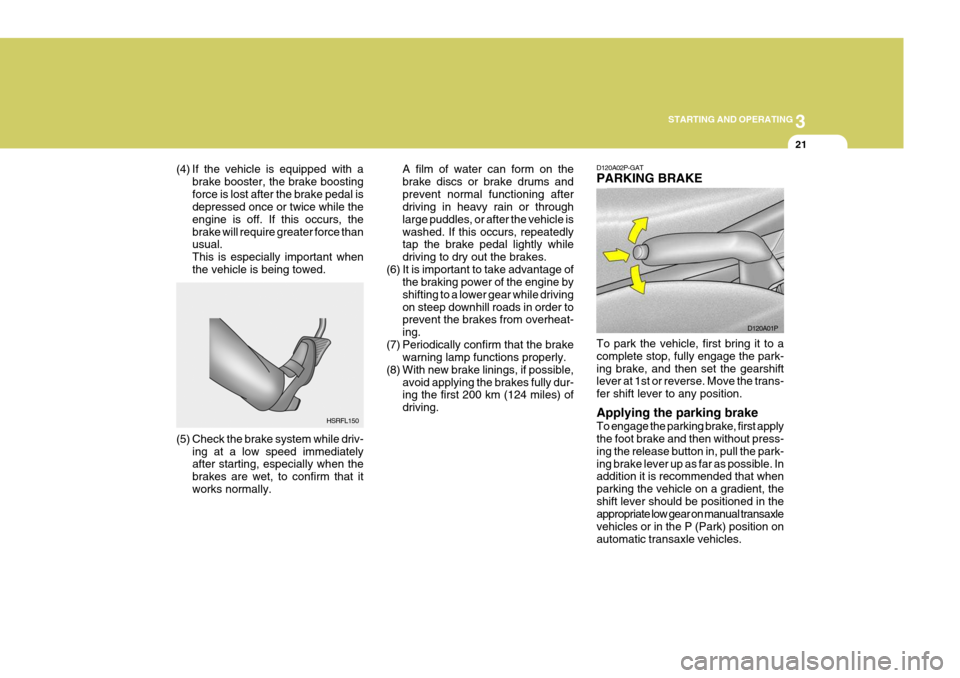
3
STARTING AND OPERATING
21
(4) If the vehicle is equipped with a
brake booster, the brake boosting force is lost after the brake pedal is depressed once or twice while the engine is off. If this occurs, thebrake will require greater force than usual. This is especially important whenthe vehicle is being towed. A film of water can form on thebrake discs or brake drums andprevent normal functioning after driving in heavy rain or through large puddles, or after the vehicle iswashed. If this occurs, repeatedly tap the brake pedal lightly while driving to dry out the brakes.
(6) It is important to take advantage of the braking power of the engine byshifting to a lower gear while drivingon steep downhill roads in order to prevent the brakes from overheat- ing.
(7) Periodically confirm that the brake warning lamp functions properly.
(8) With new brake linings, if possible, avoid applying the brakes fully dur- ing the first 200 km (124 miles) of driving.
HSRFL150
(5) Check the brake system while driv- ing at a low speed immediately after starting, especially when the brakes are wet, to confirm that itworks normally. D120A02P-GAT PARKING BRAKE To park the vehicle, first bring it to a complete stop, fully engage the park-ing brake, and then set the gearshift lever at 1st or reverse. Move the trans- fer shift lever to any position. Applying the parking brake To engage the parking brake, first apply the foot brake and then without press- ing the release button in, pull the park-ing brake lever up as far as possible. In addition it is recommended that when parking the vehicle on a gradient, theshift lever should be positioned in the appropriate low gear on manual transaxle vehicles or in the P (Park) position onautomatic transaxle vehicles.
D120A01P
Page 164 of 284
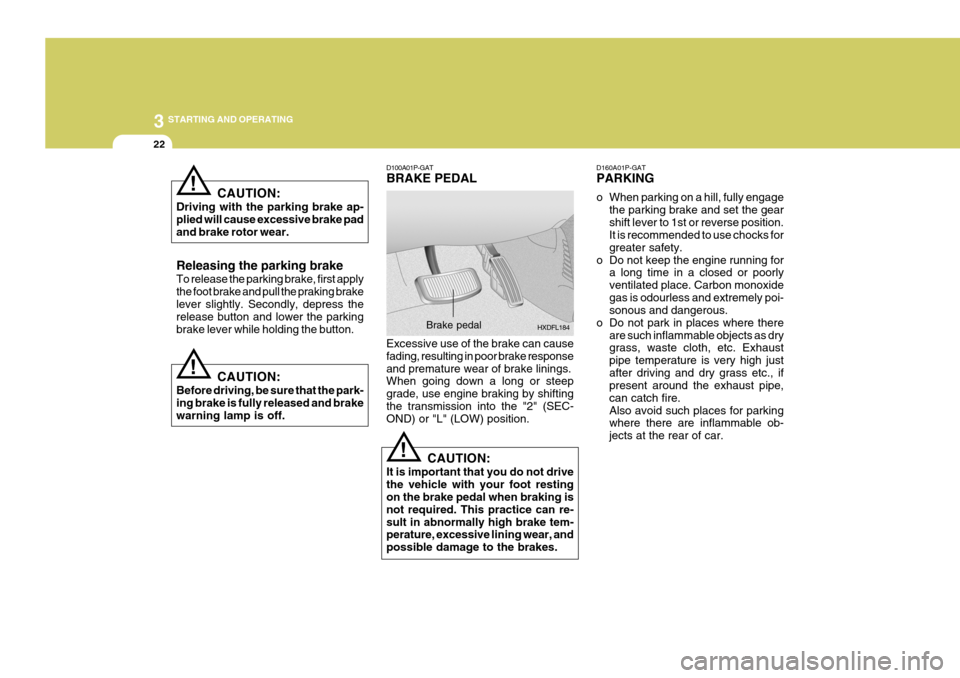
3 STARTING AND OPERATING
22
CAUTION:
Before driving, be sure that the park- ing brake is fully released and brakewarning lamp is off.! D160A01P-GAT PARKING
o When parking on a hill, fully engage
the parking brake and set the gear shift lever to 1st or reverse position. It is recommended to use chocks for greater safety.
o Do not keep the engine running for a long time in a closed or poorlyventilated place. Carbon monoxidegas is odourless and extremely poi- sonous and dangerous.
o Do not park in places where there are such inflammable objects as drygrass, waste cloth, etc. Exhaust pipe temperature is very high justafter driving and dry grass etc., if present around the exhaust pipe, can catch fire.Also avoid such places for parking where there are inflammable ob- jects at the rear of car.
D100A01P-GAT BRAKE PEDAL
CAUTION:
It is important that you do not drive the vehicle with your foot resting on the brake pedal when braking is not required. This practice can re-sult in abnormally high brake tem- perature, excessive lining wear, and possible damage to the brakes.
! HXDFL184
Brake pedal
Excessive use of the brake can cause fading, resulting in poor brake responseand premature wear of brake linings. When going down a long or steep grade, use engine braking by shiftingthe transmission into the "2" (SEC- OND) or "L" (LOW) position.
CAUTION:
Driving with the parking brake ap- plied will cause excessive brake pad and brake rotor wear. Releasing the parking brake To release the parking brake, first apply the foot brake and pull the praking brakelever slightly. Secondly, depress the release button and lower the parking brake lever while holding the button.
!
Page 165 of 284
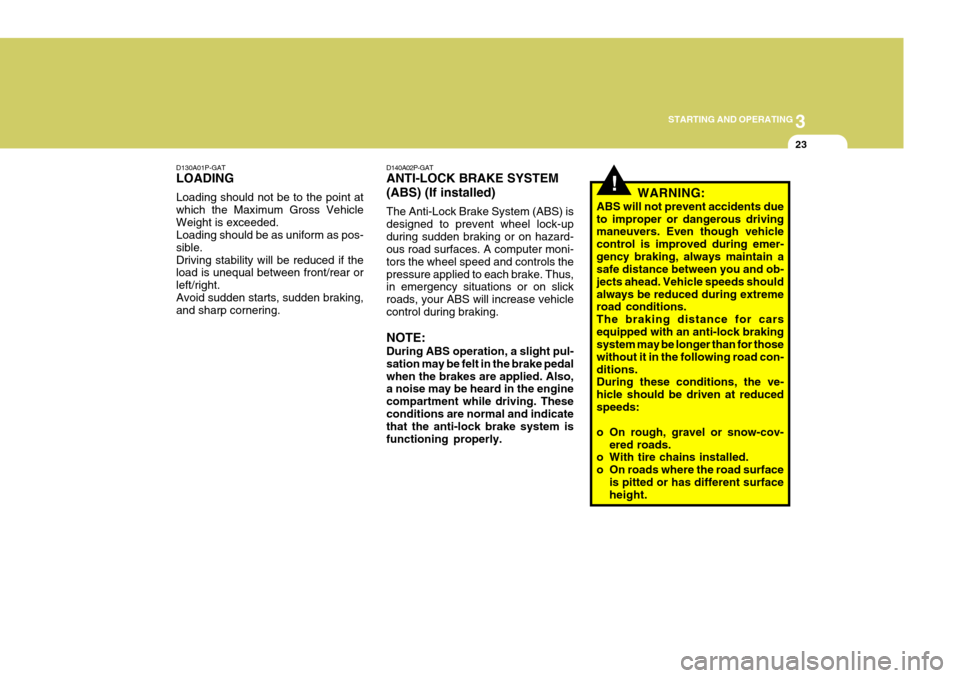
3
STARTING AND OPERATING
23
!
D140A02P-GAT ANTI-LOCK BRAKE SYSTEM (ABS) (If installed) The Anti-Lock Brake System (ABS) is designed to prevent wheel lock-upduring sudden braking or on hazard- ous road surfaces. A computer moni- tors the wheel speed and controls thepressure applied to each brake. Thus, in emergency situations or on slick roads, your ABS will increase vehiclecontrol during braking. NOTE: During ABS operation, a slight pul- sation may be felt in the brake pedalwhen the brakes are applied. Also, a noise may be heard in the engine compartment while driving. Theseconditions are normal and indicate that the anti-lock brake system is functioning properly. WARNING:
ABS will not prevent accidents dueto improper or dangerous driving maneuvers. Even though vehicle control is improved during emer-gency braking, always maintain a safe distance between you and ob- jects ahead. Vehicle speeds shouldalways be reduced during extreme road conditions. The braking distance for carsequipped with an anti-lock braking system may be longer than for those without it in the following road con-ditions. During these conditions, the ve- hicle should be driven at reducedspeeds:
o On rough, gravel or snow-cov- ered roads.
o With tire chains installed.
o On roads where the road surface
is pitted or has different surface height.
D130A01P-GAT LOADING Loading should not be to the point at which the Maximum Gross VehicleWeight is exceeded. Loading should be as uniform as pos- sible.Driving stability will be reduced if the load is unequal between front/rear or left/right.Avoid sudden starts, sudden braking, and sharp cornering.
Page 166 of 284
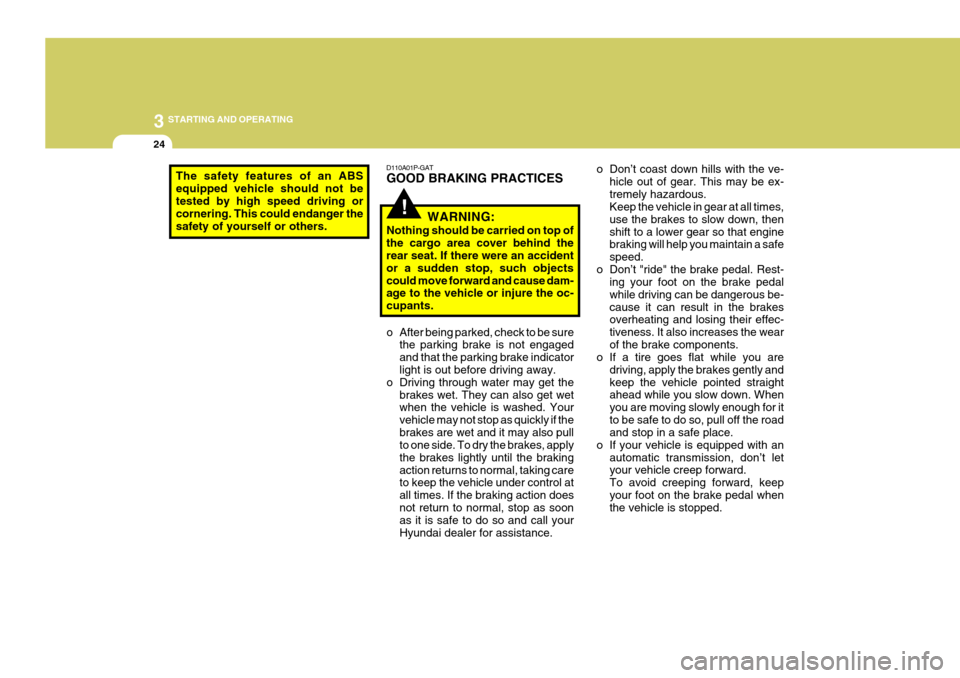
3 STARTING AND OPERATING
24
The safety features of an ABS equipped vehicle should not be tested by high speed driving or cornering. This could endanger thesafety of yourself or others.
!
D110A01P-GAT GOOD BRAKING PRACTICES
WARNING:
Nothing should be carried on top of the cargo area cover behind the rear seat. If there were an accident or a sudden stop, such objectscould move forward and cause dam- age to the vehicle or injure the oc- cupants.
o After being parked, check to be sure the parking brake is not engagedand that the parking brake indicator light is out before driving away.
o Driving through water may get the brakes wet. They can also get wetwhen the vehicle is washed. Your vehicle may not stop as quickly if thebrakes are wet and it may also pull to one side. To dry the brakes, apply the brakes lightly until the brakingaction returns to normal, taking care to keep the vehicle under control at all times. If the braking action doesnot return to normal, stop as soon as it is safe to do so and call your Hyundai dealer for assistance. o Don’t coast down hills with the ve-
hicle out of gear. This may be ex-tremely hazardous. Keep the vehicle in gear at all times, use the brakes to slow down, thenshift to a lower gear so that engine braking will help you maintain a safe speed.
o Don’t "ride" the brake pedal. Rest- ing your foot on the brake pedalwhile driving can be dangerous be-cause it can result in the brakes overheating and losing their effec- tiveness. It also increases the wearof the brake components.
o If a tire goes flat while you are
driving, apply the brakes gently andkeep the vehicle pointed straight ahead while you slow down. When you are moving slowly enough for itto be safe to do so, pull off the road and stop in a safe place.
o If your vehicle is equipped with an automatic transmission, don’t letyour vehicle creep forward. To avoid creeping forward, keepyour foot on the brake pedal when the vehicle is stopped.
Page 167 of 284

3
STARTING AND OPERATING
25REAR PARKING ASSIST SYSTEM
NOTE:
o Rear parking assist system shouldonly be considered as a supple- mentary function. The driver mustcheck the rear view.
o The audible signal can be differ-
ent depending on the objects.
o The audible signal might not acti- vate in case the sensor is frozen orstained with dirt or mud.
o There is a chance of malfunction of the rear parking assist systemwhen driving in uneven surfacessuch as woods, gravel road, jagged road, or gradient.
o Do not push, or scratch the sur- face of the sensor. This will likelydamage the covering.
o The sensor system might not rec- ognize sharp objects, thick win-ter clothes or sponges which absorb the frequency.
o Clean dirty sensors with a soft sponge and clean water.
o When more than two objects are sensed at the same time, the clos- est one will be recognized first.
C400A02P-GAT (If installed)
The rear parking assist system assists the driver during backward movementof the vehicle by chiming if any object is sensed within the distance of 1200 mm (47 in.) behind the vehicle. Thissystem is only a supplemental system. Sensor
HSRFL160
o Use caution when parking on a hill.
Engage the parking brake and place the gear selector lever in "P"(automatic transmission) or in first or reverse gear (manual trans-mission). If your vehicle is facing downhill, turn the front wheels away from the curb to help keep thevehicle from rolling. If there is no curb or if it is required by other conditions to keep the vehicle fromrolling, block the wheels.
o Under some conditions your park-
ing brake can freeze in the engagedposition. This is most likely to hap- pen when there is an accumulation of snow or ice around or near therear brakes or if the brakes are wet. if there is a risk that the parking brake may freeze, apply it only tem-porarily while you put the gear se- lector lever in "P" (automatic trans- mission) or in first or reverse gear(manual transmission) and block the rear wheels so the vehicle cannot roll. Then release the parking brake.